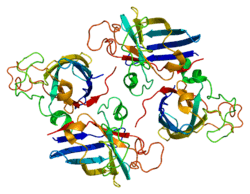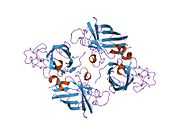CCS (gene)
Copper chaperone for superoxide dismutase is a metalloprotein that in humans is encoded by the CCS gene.[1][2]
Function
Copper chaperone for superoxide dismutase specifically delivers Cu to copper/zinc superoxide dismutase and may activate copper/zinc superoxide dismutase through direct insertion of the Cu cofactor.[2]
Interactions
CCS (gene) has been shown to interact with SOD1[3] and APBA1.[4]
References
- ↑ Culotta VC, Klomp LW, Strain J, Casareno RL, Krems B, Gitlin JD (1997). "The copper chaperone for superoxide dismutase". J. Biol. Chem. 272 (38): 23469–72. doi:10.1074/jbc.272.38.23469. PMID 9295278.
- ↑ 2.0 2.1 "Entrez Gene: CCS copper chaperone for superoxide dismutase".
- ↑ Casareno RL, Waggoner D, Gitlin JD (1998). "The copper chaperone CCS directly interacts with copper/zinc superoxide dismutase". J. Biol. Chem. 273 (37): 23625–8. doi:10.1074/jbc.273.37.23625. PMID 9726962.
- ↑ McLoughlin DM, Standen CL, Lau KF, Ackerley S, Bartnikas TP, Gitlin JD et al. (2001). "The neuronal adaptor protein X11alpha interacts with the copper chaperone for SOD1 and regulates SOD1 activity". J. Biol. Chem. 276 (12): 9303–7. doi:10.1074/jbc.M010023200. PMID 11115513.
Further reading
- Casareno RL, Waggoner D, Gitlin JD (1998). "The copper chaperone CCS directly interacts with copper/zinc superoxide dismutase". J. Biol. Chem. 273 (37): 23625–8. doi:10.1074/jbc.273.37.23625. PMID 9726962.
- Rothstein JD, Dykes-Hoberg M, Corson LB, Becker M, Cleveland DW, Price DL et al. (1999). "The copper chaperone CCS is abundant in neurons and astrocytes in human and rodent brain". J. Neurochem. 72 (1): 422–9. doi:10.1046/j.1471-4159.1999.0720422.x. PMID 9886096.
- Rae TD, Schmidt PJ, Pufahl RA, Culotta VC, O'Halloran TV (1999). "Undetectable intracellular free copper: the requirement of a copper chaperone for superoxide dismutase". Science 284 (5415): 805–8. doi:10.1126/science.284.5415.805. PMID 10221913.
- Lamb AL, Wernimont AK, Pufahl RA, O'Halloran TV, Rosenzweig AC (2000). "Crystal structure of the second domain of the human copper chaperone for superoxide dismutase". Biochemistry 39 (7): 1589–95. doi:10.1021/bi992822i. PMID 10677207.
- Moore SD, Chen MM, Cox DW (2000). "Cloning and mapping of murine superoxide dismutase copper chaperone (Ccsd) and mapping of the human ortholog". Cytogenet. Cell Genet. 88 (1-2): 35–7. doi:10.1159/000015480. PMID 10773661.
- Bartnikas TB, Waggoner DJ, Casareno RL, Gaedigk R, White RA, Gitlin JD (2000). "Chromosomal localization of CCS, the copper chaperone for Cu/Zn superoxide dismutase". Mamm. Genome 11 (5): 409–11. doi:10.1007/s003350010078. PMID 10790544.
- Rae TD, Torres AS, Pufahl RA, O'Halloran TV (2001). "Mechanism of Cu,Zn-superoxide dismutase activation by the human metallochaperone hCCS". J. Biol. Chem. 276 (7): 5166–76. doi:10.1074/jbc.M008005200. PMID 11018045.
- McLoughlin DM, Standen CL, Lau KF, Ackerley S, Bartnikas TP, Gitlin JD et al. (2001). "The neuronal adaptor protein X11alpha interacts with the copper chaperone for SOD1 and regulates SOD1 activity". J. Biol. Chem. 276 (12): 9303–7. doi:10.1074/jbc.M010023200. PMID 11115513.
- Silahtaroglu AN, Brondum-Nielsen K, Gredal O, Werdelin L, Panas M, Petersen MB et al. (2002). "Human CCS gene: genomic organization and exclusion as a candidate for amyotrophic lateral sclerosis (ALS)". BMC Genet. 3: 5. doi:10.1186/1471-2156-3-5. PMC 107843. PMID 11991808.
- Bertinato J, L'Abbé MR (2003). "Copper modulates the degradation of copper chaperone for Cu,Zn superoxide dismutase by the 26 S proteosome". J. Biol. Chem. 278 (37): 35071–8. doi:10.1074/jbc.M302242200. PMID 12832419. Vancouver style error (help)
- Silahtaroglu AN, Jensen LR, Harboe TL, Horn P, Bendixen C, Tommerup N et al. (2004). "Sequencing and mapping of the porcine CCS gene". Anim. Genet. 35 (4): 353–4. doi:10.1111/j.1365-2052.2004.01150.x. PMID 15265083.
- Jin J, Smith FD, Stark C, Wells CD, Fawcett JP, Kulkarni S et al. (2004). "Proteomic, functional, and domain-based analysis of in vivo 14-3-3 binding proteins involved in cytoskeletal regulation and cellular organization". Curr. Biol. 14 (16): 1436–50. doi:10.1016/j.cub.2004.07.051. PMID 15324660.
- Stasser JP, Eisses JF, Barry AN, Kaplan JH, Blackburn NJ (2005). "Cysteine-to-serine mutants of the human copper chaperone for superoxide dismutase reveal a copper cluster at a domain III dimer interface". Biochemistry 44 (9): 3143–52. doi:10.1021/bi0478392. PMID 15736924.
- Duquesne AE, Ruijter M, Brouwer J, Drijfhout JW, Nabuurs SB, Spronk CA et al. (2005). "Solution structure of the second PDZ domain of the neuronal adaptor X11alpha and its interaction with the C-terminal peptide of the human copper chaperone for superoxide dismutase". J. Biomol. NMR 32 (3): 209–18. doi:10.1007/s10858-005-7333-1. PMID 16132821.
- Caruano-Yzermans AL, Bartnikas TB, Gitlin JD (2006). "Mechanisms of the copper-dependent turnover of the copper chaperone for superoxide dismutase". J. Biol. Chem. 281 (19): 13581–7. doi:10.1074/jbc.M601580200. PMID 16531609.
| |||||||||||



